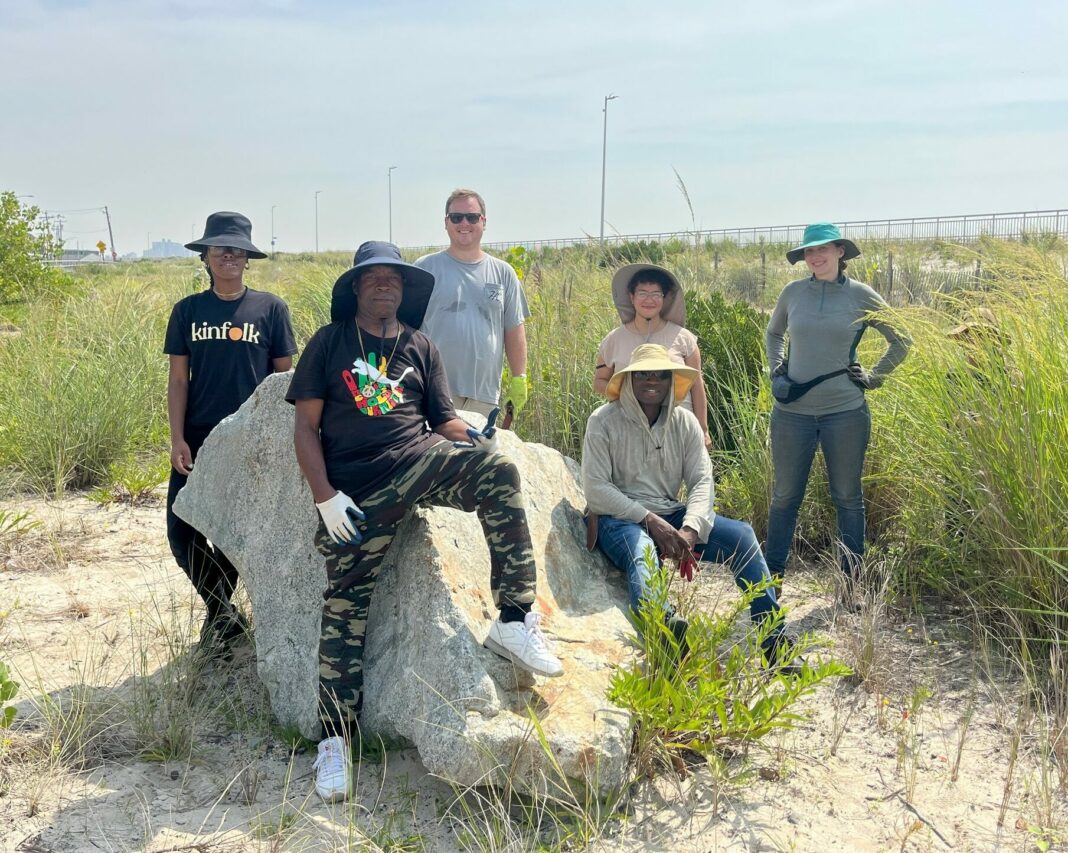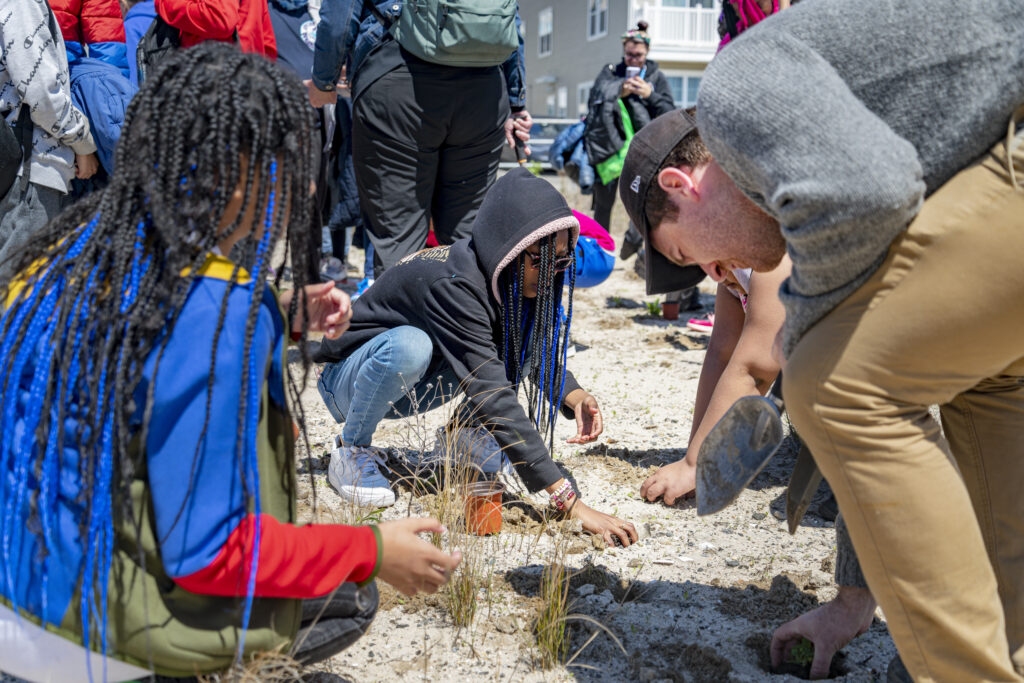New York City’s Rockaway residents are focused on restoring native species along the shoreline to protect dunes and thwart erosion.
In 2012, Superstorm Sandy evoked a sense of helplessness in thousands of people — the citizens of the Rockaway Peninsula in New York City (also known as the Rockaways) were not immune. But natural disasters can provoke human action, and no one knows this better than RISE (Rockaway Initiative for Sustainability & Equity), a nonprofit that brings residents together to improve their built and natural environment. RISE is embarking on perhaps its most ambitious project yet: The “Greater Rockaway” Coastal Enhancement Plan.
This initiative serves to restore the secondary dunes along the Atlantic shoreline in the Rockaways; by replacing invasive plant species with native species, a biodiverse dune system will return and help protect the area from flooding (in tandem with the U.S. Army Corps of Engineers’ construction of artificial dunes that will act as a physical barrier to dangerous waters). Seaside goldenrod, beach plum, rosa carolina, and milkweed are some of the plants native to this area.
“Planting native species protects against dune erosion, which in turn protects the community against flooding,” RISE’s Public Programs Coordinator Juvie Anne Alfeche explains, “because the plant roots hold the sediments — the sand — in place. That helps to stabilize the areas. The plants absorb water, which reduces runoff and holds the sand down.”
A seemingly effective idea, but no small task. Luckily, RISE is equipped with a superpower that has helped them time and time again — the locals. And many of these locals are not even old enough to vote.
RISE offers plenty of involvement opportunities for people of all ages. For example, some of the native plants needed for the dune area were germinated and later planted by elementary school children from PS 183Q through RISE’s “Living Classroom” program.
Adults can volunteer in a variety of different ways, and teenagers can apply to work (and earn a stipend) in two different environmentally focused programs — “Environmentor” and “Shore Corps.” For many of these teenaged changemakers, Sandy, whose destruction they witnessed as young children, left a lasting impression.
“My mom’s car got ruined, and then we couldn’t really go anywhere,” former Environmentor student Tayauna remembers. “So now we’re doing something that can help stop all the water from going towards people’s houses.”
That “something” means acting as an essential part of the planning and implementation process. (You can read the entire 200-page plan here.) As residents of the Rockaways and up-and-coming experts in their field, the students’ voices and ideas carry as much weight as those of the team of professional architects, urban planners, and ecologists they work with. And the teens lend not only their brains to the mission, but also their brawn — they weed, remove trash, and plant (along with a gardening crew, RISE employees, adult volunteers, and the younger school children).
Seeing all the water rushing through the streets and (me) just kind of sitting there … I felt very helpless.
— Andriana, Rockaway resident and former Environmentor student
The RISE team knew that community engagement was key, so over the course of a year, they developed a plan to activate the neighborhood. Through focus groups, surveys, public presentations, and workshops, RISE worked to make inclusion in the dune restoration initiative as accessible as possible. By offering low-commitment undertakings, the team hypothesized that they might attract more people willing to help. Altogether, their efforts reeled in the assistance of 1,068 adult residents, thirty-three local businesses and civic associations, and sixteen young adults. (This does not include the more than 2,000 students that RISE’s regular programs attract.) Surfers, beachgoers, and other residents attended meetings about the plan via Zoom, and afterward, many were inspired to take action. Some joined the Shore Corps on the ground; others volunteered to advocate with elected officials, educate their neighbors, or share RISE’s social media posts on their own accounts.
Another goal of the Coastal Enhancement Plan was replicability and scalability, in the hopes that other coastal communities might be able to use it as a model. Time needs to pass before RISE can collect enough data to determine the effectiveness of the plan (although, unofficially, Alfeche spotted more bees and butterflies this past summer), but before launching this project, RISE looked to past efforts for pointers:
“The Coastal Enhancement Plan was inspired by plantings done by another community-based organization in Far Rockaway that had led similar efforts before Storm Sandy,” says RISE founder and executive director Jeanne DuPont. “The Beachside Bungalow Preservation Association (BBPA) had received funding from the New York State Department of Environmental Conservation starting in 2005 to plant native trees and shrubs in the dunes to create an enhanced dune system. As a result, when Storm Sandy hit the Rockaways, one of the only areas not affected by the storm surge was the housing along these blocks. These plantings protected the area of housing located directly behind them and did not allow the ocean to breach the dunes. It’s important to note that these efforts were not led by any government agency, but over many years by BBPA and the local youth they had employed to help with the plantings.”
It is a massive enterprise to completely prevent flooding in a community, but RISE has a massive support system on their side: the New York City Department of Parks and Recreation, the New York State Department of Environmental Conservation, the US Army Corps of Engineers, the National Fish and Wildlife Foundation, and several NYC-based design and architectural companies are all working hard to address this serious problem. As are, of course, RISE’s very own neighbors.
What You Can Do
- If you’re in or visiting New York City, sign up to help plant on Saturday, October 21st from 10am to 1pm where Beach 62nd Street meets Beach Front Road. Or, you can volunteer with RISE to help any time.
- Arm yourself with knowledge.
- Inform your elected and office officials of the damage that can be done if no solutions to flooding are attempted. Find your local representative here.
- Pick up trash in your neighborhood on your own or with a group. Or organize trash clean-up days! Litter can clog storm drains and contribute to flooding.




